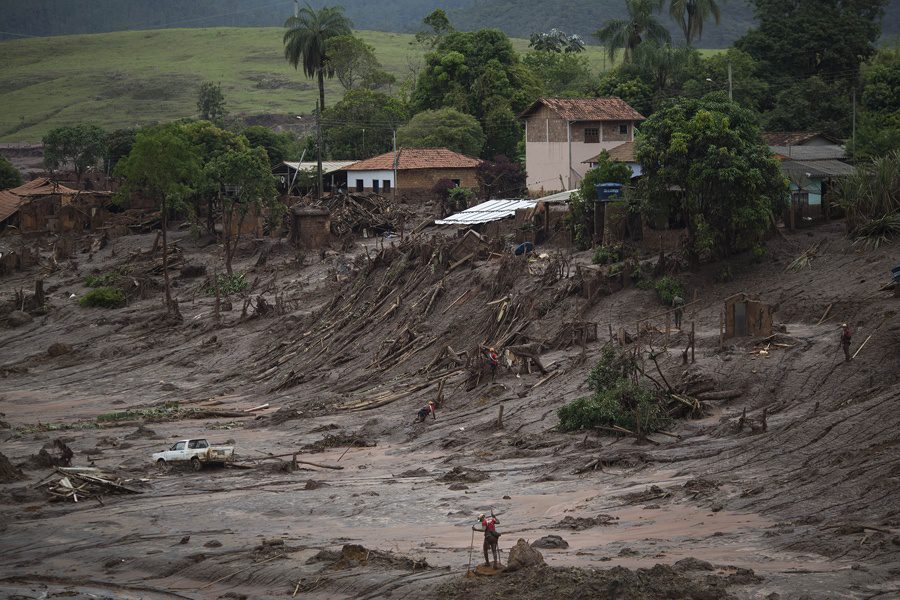New research validated: mining disasters on the rise because of modern mining techniques
EARTHWORKS News Release
Washington, D.C. — A mine waste dam at the Germano open-pit iron ore mine in Brazil’s state of Minas Gerais breached Thursday, flooding the downstream area with mining waste and causing fatalities. The Germano facility is co-owned by two of the world’s largest mining companies, Brazilian Vale SA and Anglo-Australian BHP Billiton.
A recent report, The Risk, Public Liability & Economics of Tailings Storage Facility Failure, demonstrates that catastrophic mine waste failures are increasing in frequency and severity because of — not in spite of — modern mining techniques, and will continue to do so until regulators and mining companies take active steps to prevent them.

Rescue workers walk at the site where the town of Bento Rodrigues stood after two dams burst on Thursday, in Minas Gerais state, Brazil, Sunday, Nov. 8, 2015. Brazilian rescuers are looking for people still listed as missing following the burst of two dams at an iron ore mine which sent viscous red mud, water and debris flooding into the town, flattening all but a handful of buildings and killing dozens. (AP Photo/Felipe Dana)
“Our research shows that more mining waste disasters like Brazil’s Germano spill are inevitable,” said David Chambers, report co-author and director of the Center of Science in Public Participation. He continued, “If mining practices continue as usual, we are going to see more severe spills, more frequently. These spills each will cost the public hundreds of millions to billions of dollars to clean up – if cleanup is possible at all. And sometimes, like the Germano spill, they will cost people’s lives.”
Chambers’ report, co-authored with Lindsay Newland Bowker, was researched in response to the 2014 Mount Polley mine waste disaster in British Columbia, another waste impoundment failure which released roughly 24.4 million cubic meters of mine tailings waste into the Fraser River watershed. An expert panel commissioned by the BC provincial government recommended the global mining industry make significant changes to how it handles mining waste. To date those recommendations have been largely ignored.
“The Mount Polley disaster should have been a wake-up call to the mining industry,” said Earthworks’ mining director Payal Sampat. She continued, “But mining companies and government regulators failed to act – and tragically, now mining spills are killing people as well as wildlife. We cannot afford to wait for the next mining disaster before we protect communities and the environment from risky mining practices.”
There are 839 mining waste tailings dams in the United States and approximately 3,500 around the world, according the U.S Army Corps of Engineers and the United Nations, respectively. Large dams built to contain mining waste, among the largest structures in the world, must stand in perpetuity. Yet there is no federal agency in the U.S., nor global entity, responsible for oversight of mining waste tailings dam safety. 38 civil society organizations around the world urged the United Nations Environment Programme (UNEP) to push companies and national governments to address the threats mine waste dams pose. UNEP Director Achim Steiner responded with plans to review current guidance and work with stakeholders to examine next steps. Efforts are also underway to pressure US and Canadian governments to take stock of mining waste tailings dams.
Primary findings of The Risk, Public Liability & Economics of Tailings Storage Facility Failure include:
- The rate of serious tailings dam failures is increasing. Half (33 of 67) of serious tailings dam failures in the last 70 years occurred in the 20 years between 1990 and 2009.
- The increasing rate of tailings dam failures is propelled by, not in spite of, modern mining practices. The increasing rate of tailings dam failures is directly related to the the increasing number of TSFs larger than 5 million cubic meter capacity necessitated to allow the economic extraction of lower grades of ore.
- 11 catastrophic failures are predicted globally from 2010 to 2019. Predicted total cost of these 11 failures is approximately $6 billion.
- The average cost of the these catastrophic tailings dam failures is $543 million. Regulator attempts to recoup cleanup costs from mining operators reveal — through court records and other official documents — dollar totals for cleanup and recovery.
- Mining companies cannot afford, and cannot secure insurance to cover, the costs of catastrophic failures: Losses, both economic and ecological, are in large part either permanent and non-recoverable, or recovery — to the extent physically possible — is funded by public monies.










